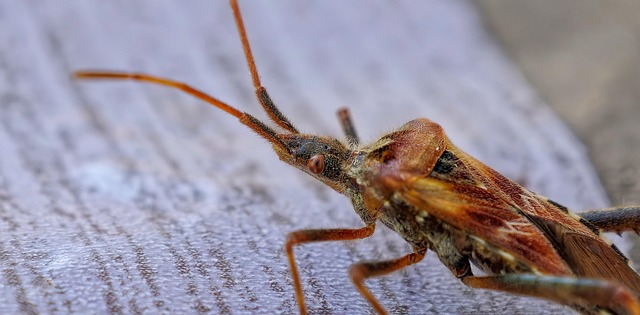Traditional bed bug extermination methods using chemicals are ineffective due to health risks, resistance, and lingering residue. Advanced technologies like sensors and heat treatment are transforming the industry. Heat treatment, with precise temperature control, is a leading eco-friendly solution, offering quicker results and minimal disruption compared to traditional methods. Future innovations include AI and IoT for more accurate identification and prediction of infestations, further minimizing chemical use and optimizing professional bed bug extermination services.
In the realm of pest control, bed bugs pose a persistent challenge for both homeowners and professionals. Traditional methods, though effective, have limitations and gaps that innovative technologies aim to bridge. This article explores cutting-edge solutions transforming the landscape of bed bug management. From heat treatment, a proven game-changer, to the potential of AI and IoT, we delve into the future of professional bed bug extermination, offering safer, more efficient strategies for a peaceful night’s sleep.
Traditional Bed Bug Extermination Methods: Limitations and Gaps
Traditional methods of bed bug extermination, while effective in some cases, often face significant limitations and gaps. Chemical pesticides remain a common go-to for professional bed bug extermination, but they can have drawbacks such as health risks to occupants, environmental impact, and growing resistance from pest populations over time. These chemicals may also leave behind residual traces that can persist for weeks or even months after treatment, causing concerns about safety and long-term exposure.
Furthermore, traditional methods often struggle with pinpointing the exact extent of an infestation, leading to incomplete treatments. Bed bugs are elusive and can hide in hard-to-reach areas, making it challenging for professionals to detect all stages of the pest’s life cycle. This results in inadequate extermination attempts, requiring multiple rounds of treatment, which increases costs and time commitments for both property owners and professional exterminators.
Emerging Technologies for Effective Detection and Eradication
The world of professional bed bug extermination is witnessing a remarkable transformation with the advent of innovative technologies. One prominent approach involves the use of advanced sensors and monitoring systems that detect even the faintest traces of bed bugs and their pheromones, providing early warning signs for exterminators. These sensors can be strategically placed in hard-to-reach areas, ensuring a thorough inspection process.
Furthermore, heat treatment methods and advanced lighting techniques are revolutionizing eradication strategies. Modern heat treatment systems employ precise temperature control to eliminate bed bugs effectively, minimizing the risk of damage to personal belongings. Similarly, specialized lighting equipment attracts and traps these pests, offering a non-toxic and eco-friendly solution for professional bed bug extermination services.
Heat Treatment: A Professional's Go-To Solution
Heat treatment has emerged as a go-to solution for professionals in the field of bed bug extermination. This innovative technology utilizes precise temperature control to eliminate bed bugs and their eggs at all life stages, making it an effective and efficient method for both residential and commercial spaces. The process involves raising the ambient temperature to levels that are harmful to the bed bugs but safe for human occupation and most materials.
Compared to traditional methods, heat treatment offers several advantages, including faster results, less disruption to daily activities, and reduced reliance on harsh chemicals. It is particularly useful in hard-to-reach areas and crevices where bed bugs tend to hide, ensuring a thorough and comprehensive extermination. Professionals skilled in this technique employ specialized equipment and monitoring systems to ensure the optimal temperature range is maintained for the desired duration, making it a reliable choice for effective professional bed bug extermination.
The Future of Bed Bug Control: AI, IoT, and Beyond
The future of bed bug control looks promising with advancements in Artificial Intelligence (AI), Internet of Things (IoT), and other innovative technologies. These tools are transforming professional bed bug extermination services, enabling more precise and efficient detection methods. AI algorithms, for instance, can analyze data from various sensors to identify subtle signs of bed bug activity, helping exterminators pinpoint hidden infestations faster. This technology also facilitates the monitoring of treatment effectiveness in real-time, ensuring that every corner is free from these pests.
IoT devices, such as smart traps and sensors, play a crucial role in early detection and localized treatment. These interconnected devices can detect bed bug movement, identify species types, and even predict infestation patterns. By integrating these innovations into their arsenal, professional bed bug extermination services can offer more tailored and environmentally friendly solutions, minimizing the use of harsh chemicals and optimizing control strategies for both residential and commercial spaces.
In conclusion, while traditional methods of bed bug extermination have long been the go-to for professionals, emerging technologies offer promising solutions to improve detection and eradication. Heat treatment, AI, and IoT devices like smart traps and sensors are revolutionizing the industry, providing more efficient and targeted approaches. As these innovations continue to develop, they will play a pivotal role in ensuring effective professional bed bug extermination while minimizing environmental impact and costs.
